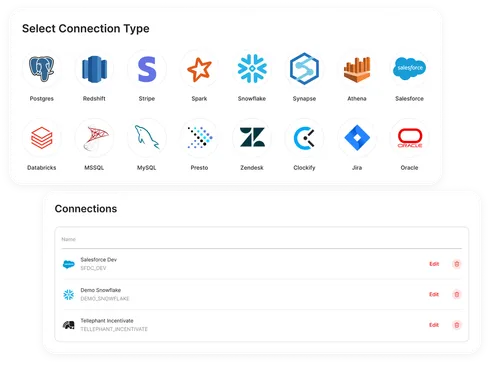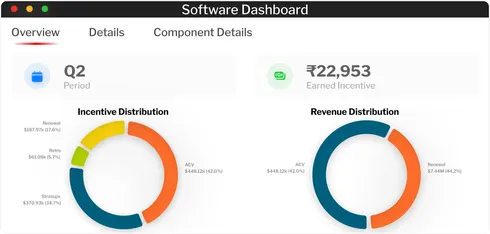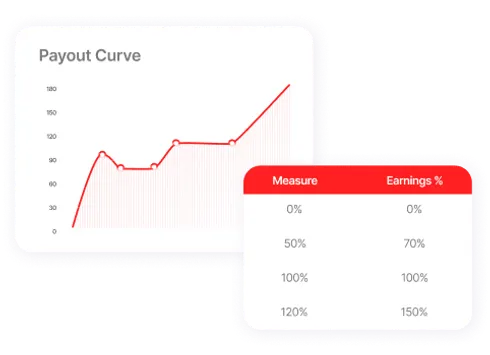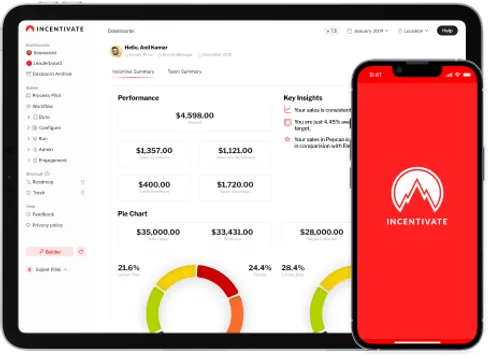
Sales Compensation for SaaS Organizations
Organizations are increasingly using SaaS applications today. It’s amongst the fastest growing industries with approx $170 Bn worth today; i.e 2022. It has grown 500% in the last 5 years and is seen as the most important tech aspect for any business to succeed. Let’s look at a few numbers to put things in perspective;
○ The average number of SaaS apps used per organization stands at approx 80
○ SaaS applications account for 70% of total company software use
○ 20% of SaaS spending was unaffected during the COVID pandemic
○ The US alone has 17000 SaaS companies
○The industry is set to double its size in the next 3 years, i.e. by 2025
These numbers confirm the increasing demand for SaaS applications. Eliminating boundaries because of the COVID pandemic has indicated that this is just the tip of the iceberg and the real growth is even higher and yet to be seen. As we move ahead with time, underlying strategies will change and newer metrics that did not hold enough significance will emerge. Global markets will add multiple currency management challenges while penetration levels will impact the quota setting process across geographies. The number of salespeople employed will increase significantly at the same time attrition rates will skyrocket because of the ease of getting one thanks to boundary-less operations. This also means your compensation plans will have to change to entice, engage, and motivate the sales force.
Incentivate has been lucky enough to not only ride but also leverage the learnings with this wave. Inherently being a SaaS application, we understand the space and associated drivers better than many. Hundreds of SaaS organizations across all sizes, geographies, and domains have benefitted from our no-code builder and pre-configured data models built for SaaS organizations. Pre-built connectors highlighted in the next section have made manual work redundant and no-code ability has made sales operations personnel self-sufficient when it comes to updating incentive plans and associated dashboards in Incentivate.

Common Data Sources Integrated
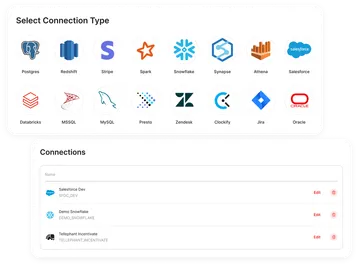
Typical Components in a SaaS Sales Compensation Plan
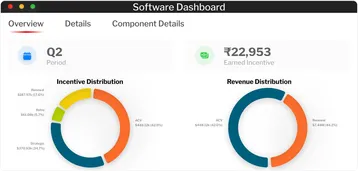
On-Target Earnings
Incentives / Commissions earned by the salesperson upon hitting their targets/ quota.
Annual Contract Value (ACV)/Annual Recurring Revenue (ARR)
Twelve months of software subscription revenue typically used by mid-market companies selling annual contracts.
ACV/ARR Growth
Incremental revenue successfully achieved from existing customers owing to additional users, upsells/cross-sells of other services.
ACV/ARR Renewal
Renewal of annual contracts due to expire upon completion of a year.
Monthly Recurring Revenue (MRR)
One month of subscription revenue typically used by SaaS companies offering applications on monthly contracts.
Multi-year Contract / Strategic Deals
Contract with a term of more than 1 year with a potential non-cancellation clause.
MBOs
Management by Objectives; typically non-sales related metrics that may be aligned with upskilling, maintaining clean opportunities data in CRMs for better analysis and forecasting, or even setting up sales best practices. These are usually quantified based on scoring done by managers.
New Business
Getting a new client can attract a special incentive as it’s a foot-in-the-door opportunity to farm and increase the revenue in long-term.
Services Revenue
From a valuation perspective, these are less lucrative; however, they offer very strong support in terms of ensuring usage continuity of the SaaS application bought by the client.
Billing
Revenue Recognition of the orders placed by the client.
Gross Margin (GM)
Organizations have started giving a free hand to salespeople when it comes to working out deal rates. However, they have limited the reduction in revenue by incentivizing the Gross Margin associated with the deal. With this, a salesperson tries to sell at higher rates effectively getting a better incentive for himself as a more profitable deal for the organization.
Hold and Release
Collecting revenue for SaaS application usage can be a big headache. Organizations incentivize salespeople on their ability to ensure there’s a continuous/timely collection of dues from the client. Sales Compensation differs (read as reduce) as the number of days for clients to pay up increases.
SPIFs / Kickers / Bonus
Additional bonuses paid for multi-year deals, end-of-quarter/annual pushes, upsell, cross-sell, etc.
Processing & Payout Frequency
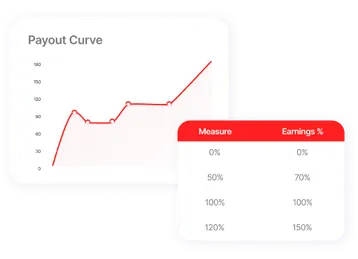
A majority of SaaS organizations have monthly or quarterly sales compensation plans with an opportunity for salespeople to catch up on missed quotas in subsequent quarters or at an annual level. However, remote first and globally distributed teams have mandated a need for more frequent updates to ensure salespeople have enough visibility into their earning potential. Additionally, upstream and downstream integrations make data flow relatively simpler. As a result, SaaS organizations may have daily or weekly processing where Incentivate assists with a scheduler as well as with custom dashboards that refresh with every processing run. They provide relevant information and updates, assisting individuals in meeting their sales goals. They also keep track of their progress and earnings to date as well as create simulations to achieve the desired targets as laid out in their sales compensation plan. Furthermore, organizational leadership requires a unique set of reports and dashboards. These are more strategic, displaying overall corporate performance over specific periods. Periods vary depending on how your sales compensation plans are set up. To summarize, processing may happen more frequently from a visibility standpoint; however, payouts happen on a monthly or quarterly basis.
Challenges Addressed
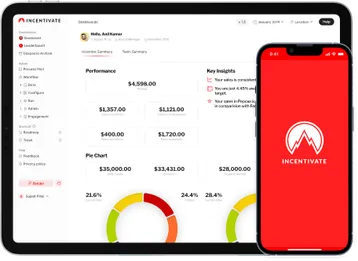
Query Management
Teams are dispersed geographically leading to time zone differences. Additionally, salespeople may have revenue quotas/targets set up as per local currency as the majority of their deals happen in local currency. Such factors always lead to a flurry of questions that may come up in a salesperson’s mind. He may struggle to get information which can get further complicated with his Sales Operations team sitting elsewhere in a different office. Incentivate comes with a native query management tool that empowers your salespeople to raise queries specific to their KPIs / Metrics. They can give reference to elements from within the application making it convenient for them and the manager to resolve the query without hopping on calls or exchanging email chains. Furthermore, from an admin standpoint, all these are audited which is an essential compliance need.
Visibility
Incentivate designs personalized dashboards for everyone that are aligned with their sales compensation plan and refreshed almost near real-time. This ensures your salespeople have enough visibility into how their incentives are calculated. Sales Compensation plans where incentives may be paid on DSO (Daily Sales Outstanding) or the number of days needed for collecting dues from customers can get complex. Salespeople may find it tough to understand their incentives and may end up shadow accounting which eats up a significant part of their sales time.
Integration
A comprehensive sales compensation plan may use data from multiple systems used by or for the sales team. This may need significant manual intervention and convolute the process leading to an effective delay in payouts. Incentiate automates this manual work and also helps in bringing structure to processes. A typical SaaS organization uses upwards of 50 CRMs across the board. Few may be out of the box while the rest may be developed in-house. Incentivate integrates with these at ease and ensures significant elimination of manual work for admins.
Data Analytics
Data Analytics is the modern buzzword. Your ability to slice and dice data to derive decision-making insights sets you apart from the competition in terms of speed and accuracy. Organizations that struggle to make data-driven decisions suffer in the long term as their sales compensation plans fail to adapt to modern-day needs. Incentivate provides out-of-the-box analytics as well as on the fly custom analytics for admins to prepare their own reports. This empowers them to read into the nuances and identify top & bottom salespeople, engagement levels, product performance, and overall effectiveness of their sales compensation plan
Self-Sufficiency
Legacy sales performance tools have created a false notion in the industry of them being needed to make changes to the application for the smallest of tweaks to sales compensation plan parameters. Incentivate’s Builder functionality quickly resolves these challenges. It allows an admin to take control of the application. It simplifies and enables admins to tweak as well as set up new sales compensation plans, SPIFs, or kickers. An admin can quickly set up parameters that can be changed and used for a given length of time. An admin can even design intuitive dashboards and what-if calculators.
Attrition
Attrition in SaaS is at its highest today. Lack of timely insights and the inability of an organization to develop a sense of transparency results in demotivation and leads to your salespeople leaving the organization. Incentivate’s ability to handle these challenges ensures salespeople have enough insights and are connected with the overall business. They understand the overall business nuances better and have an increased sense of belongingness towards the organization. Near real-time insights help them take timely decisions and avoid losing sales compensation. All of this leads to a satisfied salesperson and at the end of the day, that is what you want as an organization.
Summary
As a highly agile and ever so rapidly changing industry; SaaS is one of the catalysts for global growth in coming next few years. Engaging with & motivating their salespeople will be the key and that will be possible through a well-crafted sales compensation plan. Incentivate – an inherent SaaS solution simplifies this process effortlessly and as a result has become one of the leading providers for SaaS organizations globally.
